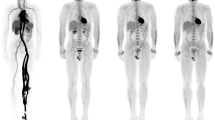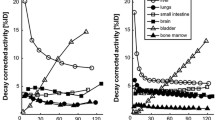Abstract.
The aim of this study was to determine the non-extremity gamma dose received by a technician while performing an ordinary nuclear medicine procedure or a static (i.e. without blood sampling) fluorine-18 fluorodeoxyglucose (FDG) positron emission tomography (PET) study. The dose per patient was measured by means of a commercial electronic pocket Geiger Mueller dosimeter, worn in the upper left pocket of the overalls. This was previously tested by exposure to known point sources of technetium-99m, gallium-67, iodine-131 and fluorine-18 in the air. A further test was performed with 99mTc, 131I and 18F sources inserted in a water phantom to simulate the condition of high scattering degradation of the primary radiation due to the patient’s tissues. Subsequently, the dose was measured by two technicians for a total of 314 clinical cases, covering the most common nuclear medicine procedures, including 44 static, two-level FDG PET studies with repositioning of the patient on the couch between the transmission and the emission scan and seven whole-body PET studies. The dose read by the dosimeter was corrected for environmental background and for detector efficiency measured with sources in the air. For a limited subset of cases, the time spent close to patients was also measured. Doses were then estimated by a crude non-absorbing point source approximation and by using experimental dose rates. A comparison between experimental and estimated doses, as well as with previously published data, completed the work. For most of the conventional procedures, the measured dose per procedure proved to be within the range 0.2–0.4 μSv, except for equilibrium angiocardioscintigraphy (1.0±0.5 μSv) and 99mTc-sestamibi single-photon emission tomography (1.7±1.0 μSv). Comparison with data published in the last 20 years shows that our values are generally lower. The current more favourable working conditions are a result of technological improvements (for instance two-head gamma cameras capable of whole-body studies), and safer shielding and distance from patients. Two-level PET gave 11.5±4.4 μSv and whole-body PET 5.9±1.2 μSv. In a subset of patients these values could be subdivided into the separate contributions from each phase of the procedure. They were: 0.11±0.04 μSv for daily quality assurance, 2.9±3.0 μSv for two transmission scans, 0.3±0.1 μSv for syringe preparation, 2.8±1.8 μSv for injection and escorting the patient to the waiting room, 1.7±1.5 μSv for a whole-body emission scan, 7.7±5.2 μSv for two emission scans, and 0.8±0.2 μSv for patient departure. The higher value from PET by comparison with conventional procedures is attributable to the higher specific gamma constant of 18F, as well as the longer time required for accurate positioning.
Similar content being viewed by others
Author information
Authors and Affiliations
Additional information
Received 11 March and in revised form 5 July 1997
Rights and permissions
About this article
Cite this article
Chiesa, C., De Sanctis, V., Crippa, F. et al. Radiation dose to technicians per nuclear medicine procedure: comparison between technetium-99m, gallium-67, and iodine-131 radiotracers and fluorine-18 fluorodeoxyglucose. Eur J Nucl Med 24, 1380–1389 (1997). https://doi.org/10.1007/s002590050164
Issue Date:
DOI: https://doi.org/10.1007/s002590050164




